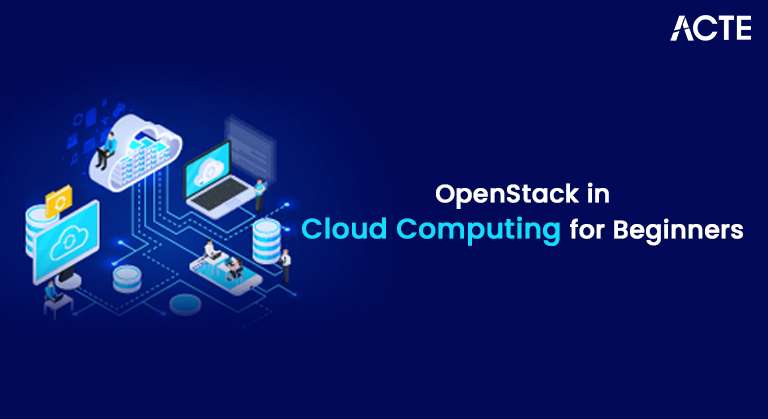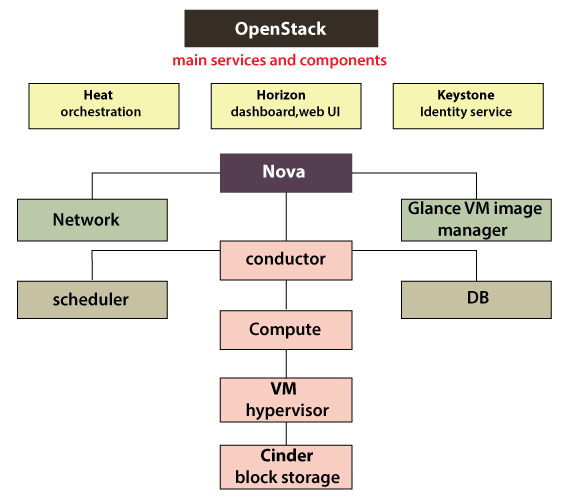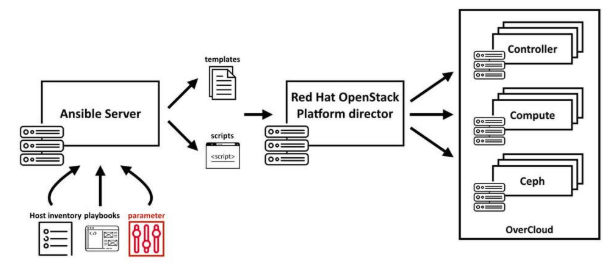
- Introduction to OpenStack
- Why OpenStack is Popular for Cloud Computing
- OpenStack Components Explained
- How OpenStack Works: Architecture Overview
- Setting Up an OpenStack Environment
- Common Use Cases for OpenStack
- OpenStack vs Other Cloud Platforms (AWS, Azure, Google Cloud)
- OpenStack Security Best Practices
- OpenStack Administration and Management
- OpenStack Certification and Career Opportunities
- Challenges in OpenStack Implementation
- Future of OpenStack in Cloud Computing
Introduction to OpenStack
OpenStack in Cloud Computing is an open-source cloud computing platform that is used to build and manage private and public cloud infrastructures. It provides a set of software tools to enable cloud services such as computing, storage, and networking. OpenStack Certification is designed to handle large-scale cloud environments, offering a flexible and cost-effective solution for organizations that need to manage their own cloud infrastructure. Cloud Computing Course is supported by a large global community of developers, engineers, and contributors who continuously improve its features and functionality. OpenStack was created by Rackspace Hosting and NASA in 2010 and has since evolved into one of the most popular open-source cloud platforms globally. The flexibility and openness of OpenStack make it a popular choice for organizations that want control over their cloud infrastructure while avoiding vendor lock-in.
Why OpenStack is Popular for Cloud Computing
OpenStack’s popularity in cloud computing is driven by several key advantages that it offers to businesses and organizations:
- Open Source and Vendor Independence: OpenStack is open-source, meaning that users can modify and extend the platform to meet their specific needs. It also allows organizations to avoid being locked into a specific vendor, which is often a concern with proprietary cloud platforms such as AWS or Azure.
- Scalability: OpenStack is designed to scale horizontally, making it suitable for handling large-scale cloud deployments. Career in Cloud Computing supports the provisioning of resources across thousands of servers, allowing users to expand their cloud environments as needed.
- Flexibility: OpenStack provides support for various hardware platforms, allowing organizations to run cloud workloads on any server, network device, or storage system. This flexibility makes it suitable for a wide range of use cases.
- Multi-Tenant Support: OpenStack Certification allows multiple users (tenants) to share the same cloud infrastructure, with each tenant having isolated resources. This feature is particularly useful in private cloud environments and for service providers that offer multi-tenant cloud solutions.
- Cost-Effectiveness: As an open-source solution, OpenStack eliminates the need for expensive licensing fees. Organizations can take advantage of the cost-saving benefits of open-source software while still benefiting from a fully functional cloud platform.
- Large Ecosystem: OpenStack is supported by a large and active community of developers, users, and organizations, which continuously contributes to the development of new features, plugins, and integrations.
Become a Cloud Computing expert by enrolling in this Cloud Computing Online Course today.
OpenStack Components Explained
OpenStack is composed of several core components that work together to provide a fully functional cloud environment. Each component is responsible for a specific set of cloud services:
- Nova: The compute component of OpenStack that provides the ability to create, manage, and scale virtual machines (VMs) in the cloud.
- Swift: TheA highly scalable object storage system that is designed to store and retrieve large amounts of unstructured data, such as files, images, and backups.
- Cinder: The block storage service in OpenStack, which provides persistent storage volumes that can be attached to virtual machines.
- Neutron: The networking component of OpenStack that provides networking services such as DHCP, DNS, and virtual networks. Neutron allows users to configure and manage networks within the OpenStack environment.
- Horizon: The web-based user interface for OpenStack that allows users to interact with the platform. Horizon provides a dashboard to manage and configure cloud resources.
- Keystone: The identity and access management component that provides authentication, authorization, and accounting services. Keystone ensures that only authorized users and services can access the resources in the cloud.
- Glance: The image service of OpenStack, which is used to manage disk images for virtual machines. Glance allows users to create, store, and retrieve images.
- Heat: The orchestration service in Mathematics for Data Science that allows users to define and manage infrastructure resources in a declarative manner, using templates to automate the creation of complex cloud environments.
- Ceilometer: The monitoring and telemetry service that collects usage data for various OpenStack services. It can be used for billing, metering, and resource optimization.
- Troves: A database-as-a-service component that provides scalable and managed relational database services.
- Ironic: The bare-metal provisioning service, which allows users to deploy and manage physical servers within the cloud infrastructure.

How OpenStack Works: Architecture Overview
OpenStack follows a modular architecture, where each component communicates with other components to provide a full cloud infrastructure. The core components are typically deployed across a set of nodes to manage different tasks, The controller node is responsible for running the core OpenStack services, including Nova, Keystone, Neutron, Glance, and Horizon. Cloud Computing Course acts as the central management point for the cloud environment. Compute nodes run the Nova component and are responsible for running virtual machines (VMs). These nodes handle the workload by providing the necessary computing resources. OpenStack can utilize multiple storage types, including block storage (Cinder) and object storage (Swift). Storage nodes are responsible for managing these storage systems. The network node is responsible for managing networking services, such as Neutron. It provides virtual networks, load balancers, and other networking functions to ensure that virtual machines can communicate with each other and external networks. The architecture of OpenStack service is highly flexible and can be scaled horizontally to handle large environments. Each component interacts through APIs and communicates over a shared messaging queue (typically RabbitMQ), which ensures coordination and management of resources.
Setting Up an OpenStack Environment
Setting up an OpenStack environment typically involves the following steps:
- Install the Base Operating System: OpenStack can run on various Linux distributions, including Ubuntu, CentOS, and Red Hat Enterprise Linux. The first step is to install a supported Linux distribution on the servers.
- Install and Configure OpenStack Components: The core components of OpenStack (Nova, Neutron, Glance, etc.) are installed and configured. This may involve setting up each component on dedicated nodes (controller, compute, storage, and network).
- Configure Networking: Since OpenStack requires networking to manage virtual machines and storage, configuring Neutron to handle networking and virtual private networks (VPNs) is critical.
- Configure Identity Management: Keystone is used to handle authentication and authorization, ensuring that only valid users and Google Cloud Platform GCP can access OpenStack resources.
- Provision and Manage Resources: Once the environment is set up, users can begin provisioning virtual machines, storage, and networks through Horizon or the OpenStack CLI.
- Monitoring and Maintenance: OpenStack services requires ongoing monitoring and maintenance to ensure performance and reliability. Tools like Ceilometer, Monasca, and Nagios can be used for monitoring.
- Private Cloud: Organizations use OpenStack to build private clouds to manage their own infrastructure and resources without relying on public cloud providers.
- Public Cloud: Some organizations use OpenStack to offer public cloud services, either as a cloud service provider or in a hybrid cloud model.
- Data Centers: OpenStack is widely used in data centers to create a unified and highly scalable infrastructure for running applications, providing storage, and managing workloads.
- DevOps and CI/CD: OpenStack can be used to create environments for DevOps pipelines and continuous integration/continuous deployment (CI/CD), making Scalable Cloud Data Warehousing With AWSaw Redshift easier to manage test and production environments.
- Disaster Recovery and High Availability: OpenStack can be configured to provide high availability and disaster recovery by distributing resources across multiple regions and availability zones.
- Pricing: OpenStack is open-source, meaning that there are no licensing fees, but users are responsible for the hardware, networking, and management costs. AWS, Azure, and Google Cloud, on the other hand, are pay-as-you-go models that offer scalability with no upfront hardware costs.
- Flexibility: OpenStackOpenStack offers more control and customization, especially for organizations that want to manage their own infrastructure. Commercial cloud providers like AWS, Azure, and Google Cloud offer managed services with less setup and configuration.
- Ease of Use: Commercial cloud platforms often have more user-friendly interfaces and better documentation compared to OpenStack, which can be complex and requires more setup.
- Support: OpenStack relies on community support, while AWS, Azure, and Google Cloud provide enterprise-level support, which can be crucial for businesses.
- User Management: Admins can create and manage users, assign roles, and set up projects using Keystone.
- Resource Provisioning: Administrators provision virtual machines, storage, and networking services through Horizon or CLI.
- Monitoring and Logging: Admins must monitor the health and performance of OpenStack services using tools like Ceilometer and Monasca.
- Backup and Recovery: Regular backups should be taken for AWS Sysops Certification data, and a disaster recovery plan should be in place to recover from potential failures.
- Complexity: OpenStack can be complex to deploy and manage, requiring expertise in networking, storage, and cloud services.
- Integration: Integrating OpenStack with existing IT infrastructure and other cloud platforms can be challenging.
- Performance: Optimizing the performance of OpenStack in large-scale environments requires careful tuning and configuration.
- Support and Documentation: While the community support for OpenStack is strong, official documentation and support from third-party vendors may be limited.
Gain in-depth knowledge of Cloud Computing by joining this Cloud Computing Online Course now.
Common Use Cases for OpenStack
OpenStack is used in a variety of scenarios due to its flexibility and scalability. Common use cases include:

OpenStack vs Other Cloud Platforms (AWS, Azure, Google Cloud)
While OpenStack is a popular open-source platform, it is important to compare it with commercial cloud platforms such as AWS, Azure, and Google Cloud. Key differences include:
Take charge of your Cloud Computing career by enrolling in ACTE’s Cloud Computing Master Program Training Course today!
OpenStack Security Best Practices
Security is a critical consideration in any cloud platform, and OpenStack in Cloud Computing provides several security features and practices to ensure the integrity and confidentiality of cloud resources Authentication and Authorization Use OpenStack’s Keystone for identity management, implementing role-based access control (RBAC) to ensure that only authorized users can access cloud resources. Data Encryption sensitive data in transit and at rest using OpenStack’s native encryption tools. Ensure that communications between services are encrypted using SSL/TLS. Secure API OpenStack’s RESTful APIs by using strong authentication mechanisms such as OAuth, tokens, or certificates to prevent unauthorized access. Regular Audits Perform regular security audits to identify vulnerabilities, monitor access logs, and ensure compliance with industry standards. Network Isolation Use Neutron’s networking capabilities to isolate different tenants and networks, ensuring that users and services cannot access each other’s resources.
OpenStack Administration and Management
Administering an OpenStack environment requires managing multiple components and services. Some key tasks include:
OpenStack Certification and Career Opportunities
OpenStack offers OpenStack Certification programs to validate expertise in managing and deploying OpenStack clouds. The Certified OpenStack Administrator (COA) certification is one of the most recognized qualifications for OpenStack professionals. Additionally, many organizations offer training programs for OpenStack. Career opportunities include roles such as OpenStack Administrator, Cloud Architect, DevOps Engineer, and Cloud Engineer. With the increasing adoption of OpenStack in large-scale environments, career prospects are strong.
Challenges in OpenStack Implementation
While OpenStack offers numerous benefits, organizations may encounter challenges when implementing it:
Are you getting ready for your Cloud Computing interview? Check out our blog on Cloud Computing Interview Questions and Answers!
Future of OpenStack in Cloud Computing
The future of OpenStack looks promising as more organizations adopt private and hybrid cloud solutions. OpenStack will continue to evolve with advancements in container orchestration, AI/ML, and edge computing. Its flexibility, scalability, and cost-effectiveness will make it an attractive option for businesses looking to maintain control over their cloud infrastructure. As the Cloud Computing Course landscape grows, OpenStack will remain a key player in providing open, vendor-independent cloud solutions for enterprises worldwide.





